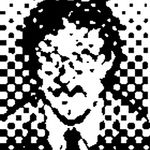- Home
- Illustrator
- Discussions
- Re: Strange border between objects of same color
- Re: Strange border between objects of same color
Copy link to clipboard
Copied
In AI, I have two similar objects overlapping. One at an angle.
In the places where their similar colors intersect, there is a tiny tiny border. Is this due to an antialiasing bug, and how can this be prevented?
 4 Correct answers
4 Correct answers
It's an anti-aliasing issue that usually only affects the display on screen. But when exporting the pixels you might have it as well.
In order to get rid of it, either unite the objects or overlap them.
Very definitely an anti-aliasing issue. The light blue and the dark blue line up precisely as objects, but when it's anti-aliased, either on the screen or exporting, the anti-aliased edge pixel of the light blue becomes half-opaque, revealing the similar half-opaque darker blue below it. You can reproduce this exact effect in Photoshop.
To eliminate it, shrink your darker blue shapes slightly so they don't line up exactly, or butt them up against each other instead of overlapping the light bl
...It is the stacking order that causes the anti-aliasing artifact.
The 2 dark blue shape is sandwiched between the light blue 1 and 3 shapes.
As suggested moving the bottom part of the dark blue shape upwards will solve the problem.
As long as you have no control over how a viewer/browser is going to render this, based on how this is currently constructed, you will always have the chance of the "line" showing up. Vector objects are rendered from the bottom up, so as lomng as you have the light blue and dark blue stacked, even exactly posotioned, the dark blue can "peek" through.
To elimiante it when generating an image format, like PNG, instead of rendering at screen resolution directly, export it first at high-res (say, 30
...Explore related tutorials & articles
Copy link to clipboard
Copied
I'm unable to attach the AI file to this post for some reason. But here's a link to it: https://shared-assets.adobe.com/link/e995f36d-a6ac-42d3-7b16-ad006cf2ae8a
Copy link to clipboard
Copied
It's an anti-aliasing issue that usually only affects the display on screen. But when exporting the pixels you might have it as well.
In order to get rid of it, either unite the objects or overlap them.
Copy link to clipboard
Copied
They are overlapping, though. And I do see it when exporting to an SVG.
Copy link to clipboard
Copied
SVG options can totally mess up your artwork. Even when the objects are overlapping.
Anything else you want to tell us about the exported artwork before someone starts to describe a fix for it? Anything that stands in the way of just uniting the shapes?
Copy link to clipboard
Copied
Hm. I can't think of anything that would preclude the use of shapes I guess. Really, this is something that Affinity Designer doesn't do well and I was hoping to see how Illustrator handles it. It's certainly better but not 100%.
How else should I export a vector for use in other applications?
Copy link to clipboard
Copied
So uniting the shapes is out of the question?
Can you please describe the issue better?
If you set up a higher Decimals value in SVG options, does it then work for you?
Copy link to clipboard
Copied
Very definitely an anti-aliasing issue. The light blue and the dark blue line up precisely as objects, but when it's anti-aliased, either on the screen or exporting, the anti-aliased edge pixel of the light blue becomes half-opaque, revealing the similar half-opaque darker blue below it. You can reproduce this exact effect in Photoshop.
To eliminate it, shrink your darker blue shapes slightly so they don't line up exactly, or butt them up against each other instead of overlapping the light blue.
Copy link to clipboard
Copied
Hi there,
Thank you for reaching out. I checked your file, and here are my observations. I hide the bounding box, smart guides, edges & switch to pixel view, and it looks like there is a tiny gap in decimal between the two elements. That's why that hairline is visible. If I press the arrow down key once it disappears. @Monika Gause, is this the case? Could you please confirm? I hope it helps!
Regards,
Anshul Saini
Copy link to clipboard
Copied
I am not seeing a gap in pixel preview.
And since this is getting worse in SVG export, then I would assume that the Decimals (precision) is causing it.
Copy link to clipboard
Copied
There is no gap between the elements. I frankly have no idea how you're getting that. Did you download the file and look at it at all?
Copy link to clipboard
Copied
Did you download the file and look at it at all?
By @kindanewtothis4738432
Obviously he did. Otherwise there wouldn't be a screenshot, right?
The way this is built is quite uncommon. Is there a reason that it's built this way? Roaringmousegraphics suggested to make the dark ractangle smaller. Any reason that you can't do that?
Can you please tell us the whole story of what you're doing with that artwork? Why can't you change that construction? Have you taken a look at the Decimals setting in SVG export?
Did you try anything that has been suggested?
Copy link to clipboard
Copied
Fair point.
I'm not sure what's so unusual here. These are two instances of the same element. One is behind the other and at an angle. Where the colors match, there is a line of division between them.
I'm not familiar with the decimals settings. Would changing that to a higher value alleviate this potentially?
Thanks for your help, all.
Copy link to clipboard
Copied
I'm not familiar with the decimals settings. Would changing that to a higher value alleviate this potentially?
By @kindanewtothis4738432
A higher value means more precision. So: yes.
Copy link to clipboard
Copied
Thank you, Monika.
Copy link to clipboard
Copied
As long as you have no control over how a viewer/browser is going to render this, based on how this is currently constructed, you will always have the chance of the "line" showing up. Vector objects are rendered from the bottom up, so as lomng as you have the light blue and dark blue stacked, even exactly posotioned, the dark blue can "peek" through.
To elimiante it when generating an image format, like PNG, instead of rendering at screen resolution directly, export it first at high-res (say, 300), with NO anti-aliasing, then downsample in Photoshop to final desired resolution.
Orrrrr.. you can modify the file... like so:
Copy link to clipboard
Copied
It is the stacking order that causes the anti-aliasing artifact.
The 2 dark blue shape is sandwiched between the light blue 1 and 3 shapes.
As suggested moving the bottom part of the dark blue shape upwards will solve the problem.
Copy link to clipboard
Copied
Copy link to clipboard
Copied
And it depends on the browser how much is visible of the anti-aliasing in the svg. Firefox on my Mac shows less than other browsers.
Find more inspiration, events, and resources on the new Adobe Community
Explore Now







